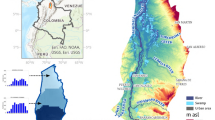Abstract
The objective of this work was to study the physicochemical conditions and the microbiological composition of underground water in the second level of the Severnyi site at the Mining and Chemical Works and to clarify the possibility of biogenic gas production by formation microflora from macrocomponents of the wastes (nitrates and sulfate ions). Chemical analysis of samples of formation liquid from wells located in the dispersion zone of the wastes showed an increase in the content of dissolved carbonic acid, sodium nitrate, and nitrates of radionuclides and an increase of their concentrations in the sampling part. In all other samples, the contents of the main cations and anions were close to the background values. Microbiological investigations showed an increase in the number of microorganisms capable of forming gases from possible macrocomponents of the wastes and in the rate of sulfate reduction and methane generation processes within the propagation boundary of the wastes.
Similar content being viewed by others
References
Summary Document of the 7th International Conference on the Safety of Nuclear Technologies: Handling of Radioactive Wastes, September 27–30, 2004, St. Petersburg (2004).
I. M. Kosareva, M. K. Savushkina, M. M. Arkhipova, et al., “Temperature field with deep burial of liquid radioactive wastes: simulation of multilevel disposal,” At. Énerg., 89, No. 6, 435–440 (2000).
I. M. Kosareva, M. K. Savushkina, Yu. M. Volin, et al., “Validation of the radiochemical characteristics of liquid radioactive wastes determining the safe operational regime of deep repositories,” ibid., 94, No. 5, 374–383 (2003).
I. M. Kosareva, M. K. Savushkina, S. A. Kabakchi, et al., “Safety assessment of liquid radioactive wastes buried for a long time in deep repositories,” ibid., 100, No. 2, 86–92 (2006).
I. M. Kosareva, M. K. Savushkina, B. G. Ershov, et al., “Release of gas with deep burial of liquid radioactive wastes,” ibid., 100, No. 1, 45–50 (2006).
T. N. Nazina, I. M. Kosareva, A. S. Davydov, et al., “Physicochemical and microbiological characteristics of underground waters from observational wells of a deep repository for liquid radioactive wastes,” Mikrobiol., 69, No. 1, 105–112 (2000).
T. N. Nazina, I. M. Kosareva, V. V. Petrunyaka, et al., “Microbiology of formation waters from the deep repository for liquid radioactive wastes Severnyi,” FEMS Microbiol. Ecol., 49, 97–107 (2004).
A. I. Rybal’chenko, M. K. Pimenov, P. P. Kostin, et al., Deep Burial of Liquid Radioactive Wastes, IzdAt, Moscow (1994).
J. West, I. McKinley, and N. Chapman, “Microbes in deep geological systems and their possible influence on radioactive waste disposal,” Rad. Waste Manag. Nucl. Fuel Cycle, 3, 1–15 (1982).
J. West, N. Christofi, and I. McKinley, “An overview of recent microbiological research relevant to the geological disposal of nuclear waste,” ibid, 6, No. 1, 79–95 (1985).
S. Stroes-Gascoyne and J. West, “Microbial studies in the Canadian nuclear fuel waste management program,” FEMS Microbiol. Rev., 20, No. 3/4, 573–590 (1997).
K. Pedersen, “Investigation of subterranean bacteria in deep crystalline bedrock and their importance for the disposal of nuclear waste,” Can. J. Microbiol., 42, 382–391 (1996).
I. McKinley, I. Hagenlocher, W. Alexander, et al., “Microbiology in nuclear waste disposal: interfaces and reaction fronts,” FEMS Microbiol. Rev., 20, No. 3/4, 545–556 (1997).
J. Domingo, C. Berry, M. Summer, and C. Fliermans, “Microbiology of spent nuclear fuel storage basins,” Current Microbiol., 37, 387–394 (1998).
G. Farkas and L. Gazso, “Characterization of subterranean bacteria in the Hungarian Upper Permian siltstone formation,” Can. J. Microbiol., 46, 559–5564 (2000).
Author information
Authors and Affiliations
Additional information
__________
Translated from Atomnaya Énergiya, Vol. 103, No. 2, pp. 106–112, August, 2007.
Rights and permissions
About this article
Cite this article
Kosareva, I.M., Safonov, A.V., Savushkina, M.K. et al. Physicochemical and biological monitoring of deep repositories for liquid radioactive wastes. At Energy 103, 615–622 (2007). https://doi.org/10.1007/s10512-007-0098-8
Received:
Issue Date:
DOI: https://doi.org/10.1007/s10512-007-0098-8




